
Welcome, from
sunny Australia!
My
New Racing Car pics &
details
My Father and I have
decided that we have
nearly reached the end of the development of my current car - though
it's still a quick car - and so the only way to get significantly more
speed from it is to simply build another one. The class of racing in
the
UK has very similar rules (apart from the engine size and other minor
details) and so we can use a chassis design similar to that used in the
UK in Australia with only minor modifications to suit the local rules.
That chassis is a Mallock Mk31, the last of the front engined Mallocks.
Virtually all of the current
running gear
will be taken out of the 'old' car, as it's very reliable, light, and
is
of high quality.
| There are
currently another two
other Mallock Mk31's in Australia, one of which was originally owned by
Phil Shaw
in
Sydney. Most of the pictures of the car below are of his car, though
mine
will be quite different in some areas, especially visually.. |
 |
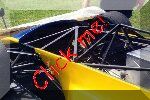 |
This is Phil's
car - You see the
removable bar in place in this picture. This photo was taken when the
car was a bare chassis, and was on its way to Sydney from Brisbane to
get finished for the 1997 Sports 1300 Nationals. The engine, gearbox,
etc, still had yet to be fitted. (The meeting was only 3 1/2 weeks
away!) |
| A view of the
drivers cockpit
area. Still a lot of tubes in the chassis! The tall points on the
chassis give it's nickname of a 'cathedral' chassis. They work very
well, and have a torsional rigidity of about 8200 ft-lbs per degree of
flex. To give you an idea what a more conventional car is like, most of
the Lotus Super Seven clones would have around 500 ft-lbs per degree! |
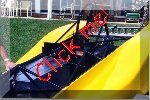 |
 |
In
this view you can
see the
aluminium box that the drivers legs sit into keep them separate from
the
engine compartment. |
|
Here
is the view
from behind the drivers head, down across the car.
|
|
 |
The front right
hand wheel and
upright. Note the fabricated upright, which uses a 'live axle' type hub
instead of the more common fixed type as on road cars. On this type of
hub, the axle that the wheel bolts onto rotates with the wheel instead
of being fixed to the upright. This a a much lighter and stiffer way of
mounting the front wheels. |
| This is a good
view of the
fabulous Mumford Link rear end. The Mumford is the only lateral link
you
can have on a live axle rear end type suspensioned car that lets you
have the roll centre as low as you'd like, for example it's possible to
have it underground. |
 |
 |
A good view of
the rear end of the
car. The large wing on the back has yet to be fitted to the two
fibreglass uprights that support it. That's my Father leaning over the
front of the car, having a look at the suspension & uprights,
and
no
doubt scheming away ... :) |
A bit of an update
 |
Here's some
newer pictures of
the car, taken in late 2000. You can see that the suspension is
basically done, and so are the brakes. What's harder to see is the
engine & gearbox mounts that're also done. If you look
carefully at
the right hand picture you can see the rockers for the front
suspension, and how they connect via a push-rod to the springs/dampers. |
 |
 |
Here's a couple
of close-ups
of the front hubs & brakes. On the left you can see the very
large
(for the size of the car) front brakes, and also the fabricated front
upright. On the right you can see the front suspension and rocker
assembly. |
 |
Late
September 2003
Not a lot has been done in recent times as we have a lot of other
projects we're working on at the same time and also the rules for the
class have recently changed & we were waiting to see how they
would
end up before we decided which way to go with the engine and bodywork.
The new rules add 1100cc and 1600cc engines to the class, and make
either the 1100cc motorbike-engined lightweight cars or the 1600cc
engined cars competitive, and will most likely leave the 1300cc cars
uncompetitive.
So we decided to go for the 1600cc class as the 1100cc class would mean
building an entirely new car from scratch. I am also too large
&
heavy for a little car! We managed to find a Nissan SR16VVL engine from
a quick Japanese Pulsar, and the factory figures claim 175hp standard.
We think that we should be able to do quite a bit better than that,
even with an 8500rpm rev limit. They have similar valve gear to the
Honda V-TEC, so they can switch from small to large cams to keep a good
torque curve over a wide rev range.
Finding a gearbox strong & light enough to fit the car was also
a
problem, but we suddenly thought of using the Hewland Mk9 from the
Can-Am replica, which now has a Porsche box instead so the Hewland was
surplus.
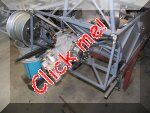
|
The
big job of fitting the Hewland transaxle to the rear of the Mallock has
begun though, and in the two pictures here you can see the tubes
connecting the gearbox to the spaceframe chassis.
The bell housing will still contain the clutch, but the tailshaft will
be in front of the gearbox instead of behind, as is typical in RWD cars.
The are a lot of little problem to solve, such the gear linkage, etc,
but we will work through them as they come.
|
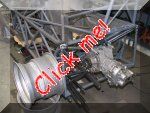
|
Late
November 2003
 |
Not a lot more
done, but the engine
for the car is in the workshop and here's a picture of the head in
bits. They run variable cam duration & lift, and it's basically
the
same as the Honda V-Tec system. The lobe centres don't alter like the
Toyota VVT allows, but it does extend the useable rev range of the
engine somewhat. The block seems to be a conventional SR20 alloy one,
with the only real difference between the engines being that this one
uses a much shorter stroke crank to bring the engine down to only 1.6
litres. The bore is still 86mm, and while the SR20 has an 86mm stroke
the SR16 has a rather short 68.7mm stroke. On the right is the engine,
as I found it in Malaysia.
More
on the Honda V-Tec & Toyota VVT gear here.
|
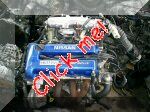
|
November
2005
 |
Very
slow progress,
but some progress of sorts.
We sold the VVL SR16 head and got a more conventional cam-on-bucket
type, as we were not convinced that the VVL gear would stay together at
the 8500rpm the engine would be running at all the time.
The rear suspension is basically done, as you can see. It's just a
matter now of finalising the ride heights front and rear so we can make
the links from the uprights to the rockers. The dampers are likely to
be Koni 2812 Mk2 L versions. |
 |
A
strong scatter
shield is needed around the flywheel in case it lets go, and parts from
it head towards my legs, which are scant inches away. We came up with
an elegant curved design that should work well - I hope it never has to!
On the left of the photo is the tailshaft containment hoop, for similar
reasons. Because the tailshaft doesn't move like a normal up, up
&
down, the hoop can be quite small though it needs unbolt so we can get
the tailshaft in & out of the car. |
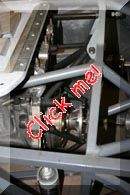 |
We
had to choose
where to put the clutch - On the flywheel or on the front of the
gearbox. We decided to put it in the conventional place as it would
allow me to decouple the drive if something goes wrong, and then stomp
on the brakes to lock the rear to stop the drivetrain from turning. If
the clutch was on the rear then the engine would always drive the
tailshaft and so it could potentially flap around until the engine
stops.
So here you can see the hydraulic centreline clutch used.
The starter motor goes on a bracket on the top of the flywheel, to make
it easy to get to if it fails. (they tend to a lot on race cars) |
We will
also be changing the bodywork to look more like a LeMans type car,
though this isn't a prority at the moment. We'll likely to just use the
current Mallock bodywork to start the testing.
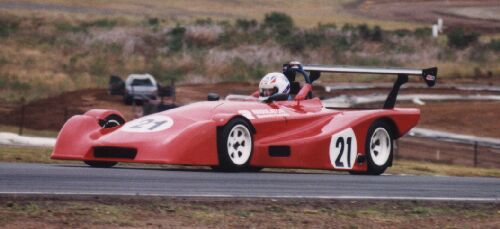
This is another view of what
it'll look like
when it's finished and the testing starts.
The
new bodywork will look
more like this though ->
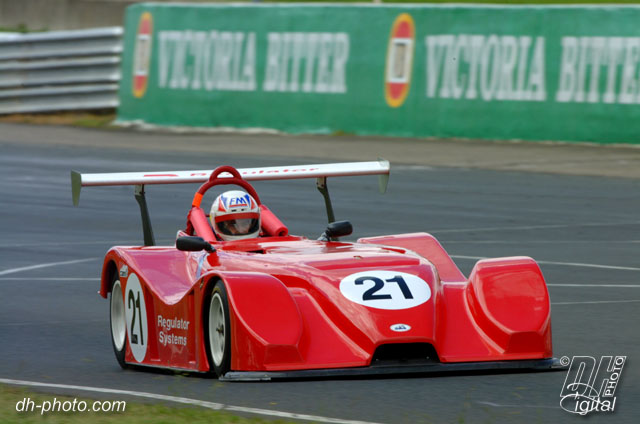
For more motorsport
links, try the motorsport
section on my links page.
Back
to the Car Index page
Back to
the Index page
Page
& contents where
applicable © Bill Sherwood






